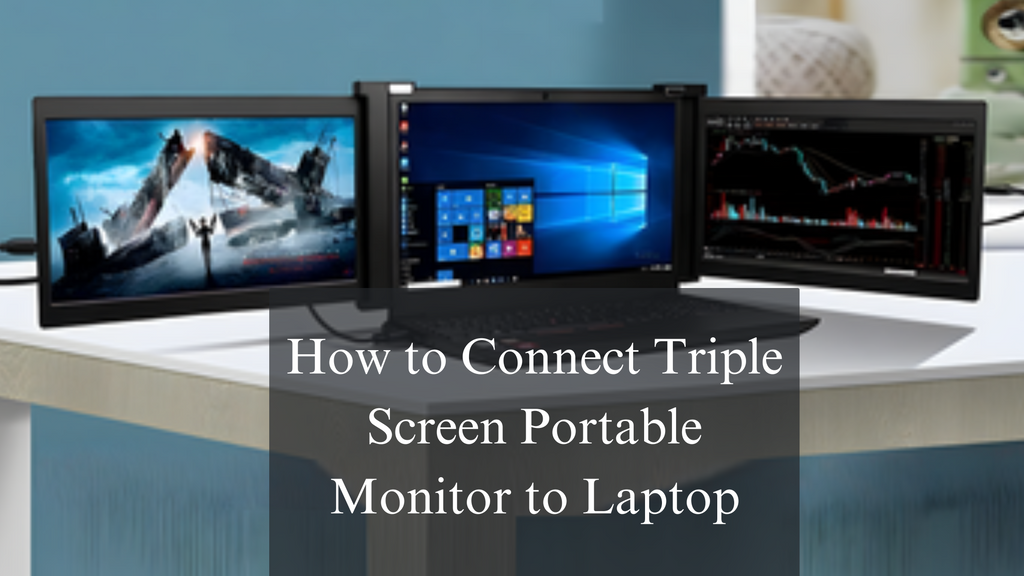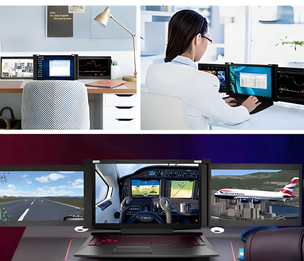How to Connect a Triple Screen Monitor to the Laptop?

What is a Triple Screen Portable Monitor?
The triple screen portable monitor is an additional pair of monitors that you can connect to the screen of your laptop to have three screens that you can work on at once. Two screens are included in tri-screen monitors, with your laptop's screen serving as the third. It is usually lightweight and foldable, making it easy to use and transport. More screen real estate is available to you when you connect your laptop to a tri-screen display. It raises output and elevates the standard of the working environment.

Steps to connect Tri-Screen Monitors to the laptop
Following are general steps to connect the tri screen monitor to the laptop:
1. Open the box and unfold the screen
2. Extend the screens apart so much that the laptop screen can slide in.
3. Slide in the screens to fit the frame of the laptop and adjust the screen according to your requirement
 4. Connect the laptop to the screens with the cables provided. (Most laptops have a built-in HDMI or VGA port that allows you to connect the display using a compatible cable. Alternatively, you can utilize a docking station or a USB to a HDMI/VGA adapter to connect the external display.)
4. Connect the laptop to the screens with the cables provided. (Most laptops have a built-in HDMI or VGA port that allows you to connect the display using a compatible cable. Alternatively, you can utilize a docking station or a USB to a HDMI/VGA adapter to connect the external display.)
You can now use these screens to help you multitask in order to increase your productivity. You could, for instance, work on a document on one screen, check drafts on another, and use the third to open your email client. Productivity can be greatly increased by multitasking to this extent. After connecting, your laptop's display settings might need to be changed in order to activate the extended screen capability. This allows for improved work organization and multitasking by allowing you to switch between windows and apps on the two screens.
Adjusting Screen Resolution and Display Settings of the Screens
The screen resolutions on your laptop and the external monitor may differ as a result of the extended screen capability. Text and image readability as well as display quality may be impacted by this. The screen resolution settings on both screens should be adjusted to match or enhance one another for the best possible visual experience.
These tri-screen monitors come with built-in features that allow you to customize the way the display works. You can customize the display settings for each screen separately based on your needs.
Following are some general display settings on these screens:
- Brightness
- Color Templates
- Image Settings
- HDR Mode
- Source Selection
- Language Settings
Degree of Rotation Of Screens
The Triple Screen Portable Monitor's screens may each rotate to a specific degree. Adding a personalized touch to the product is its most remarkable feature. These screens are incredibly adaptable and may be set up to meet specific needs and requirements. These screens rotate to varying degrees depending on the model being utilized. Numerous types offer varying degrees of rotation.
The Triple Screen Portable monitor of trio3tech, the left screen can rotate from 0 to 235 degree and the right screen can rotate from 0 to 180 degree

Organizing your Desktop
Making the most of the available workspace when using the extended screen functionality requires careful desktop organization. Depending on your preference, you can stretch a single application across both screens or have separate windows or applications active on each screen. Try a few different configurations to see which one suits your workflow best.
Extending Specific Applications
In addition to the overall extended desktop, you can choose to extend specific applications to the external display. This is particularly useful when working with applications that require a large workspace, such as video editing software or CAD programs. Simply drag the application window to the desired screen and maximize it to utilize the extended space effectively.
Optimizing Window Management
When working with an extended screen setup, it's important to optimize window management for better organization. You can use features like Snap Assist on Windows or Mission Control on macOS to easily arrange your windows on each screen. This allows you to quickly switch between applications and maintain a clutter-free work environment.
Utilizing external display as a primary monitor
If you find yourself frequently working with the extended screen setup, you can choose to make the external display your primary monitor. This means that the extended screen becomes the main display, and your laptop's screen acts as an additional workspace. This setup can be useful when using applications that benefit from a larger screen, such as graphic design software or programming IDEs.

Conclusion
The extended screen feature on a laptop can significantly enhance productivity by providing additional screen space and improved multitasking capabilities. You may take full advantage of this and streamline your workflow by paying attention to the advice provided in this article. Try a variety of configurations, tweak display parameters, and efficiently arrange your desktop to fully utilize the expanded screen capability. Share your experiences in the comments section below.